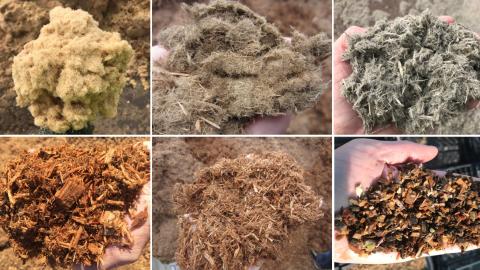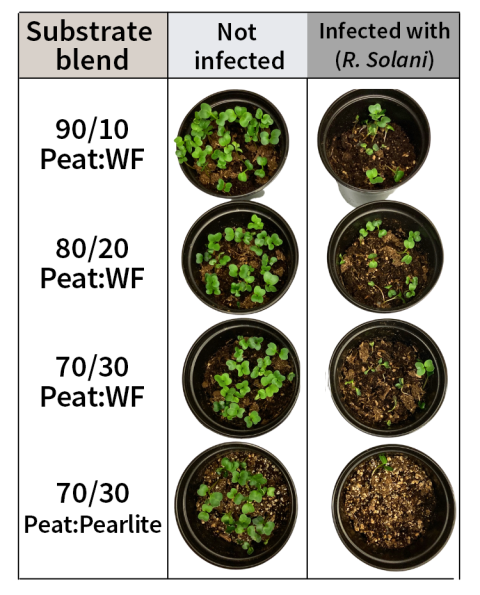Key Findings

The inclusion of wood components, regardless of blend ratio or type, does not impact severity of damping-off disease and may lessen the effect of crown and root rot.
Additional research is needed to provide guidance to growers seeking to integrate these new substrates into their operation and IPM programs.
About the Co-Author

Anissa Poleatewich, assistant professor, Agriculture, Nutrition, and Food Systems; the Poleatewich Plant Pathology at UNH
Contact information: Anissa.Poleatewich@unh.edu, 603-862-0104
This research was published in the INSPIRED: A Publication of the New Hampshire Agricultural Experiment Station (Summer 2022)
Researchers: A. Poleatewich, B. Jackson and I. Michaud
In greenhouse production, plants are not typically grown in soil but in soilless growth substrates. For decades, peat moss has been the primary substrate for container-grown ornamentals and for some vegetable crops. That is, until recently. Substrate suppliers have faced unprecedented demand, which has led to product shortages and an inability to fulfill orders. Substrate manufacturers have identified wood byproducts to be some of the most promising alternative sources of raw materials to use in substrate formulations. However, a change in substrate can be disruptive to a grower's production system, affecting everything from water to pest control. Wood components have unique properties compared to other substrates, which may affect activity of pathogenic and beneficial microorganisms. This research considers how wood substrate components affect the severity of soil-borne diseases in greenhouse horticultural crop production.

Studying peat-wood substrate mixtures
This study considers the following questions:
- Are plants grown in peat-wood substrate mixtures more or less susceptible to disease and does wood-fiber (WF) type matter?
- Does peat-wood blend ratio affect plant susceptibility to disease?

Wood components are manufactured in multiple ways, with the three most common being hammer milled, twin-disc refined and single- or twin-screw extruded. This study evaluated the three differently processed WFs for natural suppression of damping-off disease – caused by Rhizoctonia solani – on radish, as well as crown and root rot on chrysanthemum. Each substrate was blended with raw sphagnum peat at a ratio of 70:30 (peat:wood) by volume. A control blend was made up of 70 percent peat and 30 percent horticultural perlite.
Slightly lower disease severity was observed in the disc-refined wood and hammer-milled wood treatments compared to the peat control. The results suggest that the incorporation of wood components into peat may not significantly negatively or positively affect damping-off disease caused by R. solani.
WFs are commonly blended into peat at 10 to 50 percent by volume, but little is known about how that blend ratio affects the severity of soil-borne plant diseases. As such, four substrate blends (10 percent, 20 percent and 30 percent WF) were tested and compared to a peat control. For radish, the 80:20 peat:WF blend tended to have lower disease and higher aboveground plant growth compared to the peat control. On chrysanthemum, researchers observed lower disease severity in all WF treatments compared to peat. These results suggest that blend ratio does not impact plant susceptibility to disease.
Ultimately, there is still little known about the effects of wood component type and inclusion rate on soil-borne diseases and disease management. Additional research is needed to provide much needed guidance to growers seeking to integrate these new substrates into their operations and integrated pest management (IPM) programs.
Isobel Michaud, a Master's in Biological Sciences: Agricultural Sciences student in the Poleatewich Plant Pathology Lab at UNH, conducted this research.